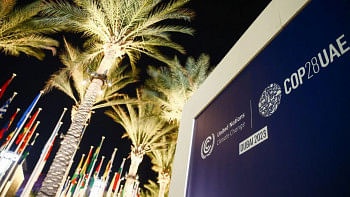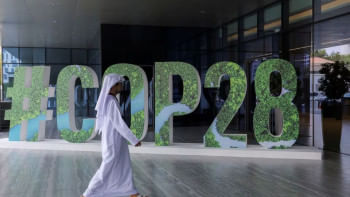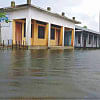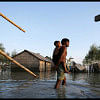What Bangladesh can do before COP29

This year's climate summit—the 28th Conference of the Parties for climate change (COP28)—started with a surprise on the very first day: the operationalisation of the Loss and Damage Fund, where the COP28 presidency pioneered a pledge of $100 million. By the end of the event, the pledges totalled almost $700 million. Though this amount is paltry compared to what is needed to combat loss and damage from climate change, the apprehension of shifting funds from adaptation and other disaster risk reduction sources appears not unfounded, given the tiny pledges of less than $200 million for the Adaptation Fund against the measly target of $300 million.
In other areas of finance, we witnessed a short shrift, a really bleak picture. Against the Glasgow decision, no clear roadmap was drawn to double adaptation finance by 2025, compared to the 2019 level. In long-term finance, a decision was made to draft a post-2025 target ahead of COP29, to be held in Azerbaijan next year. But the Green Climate Fund was pledged an additional $3.5 billion for its second replenishment, which now totals $12.8 billion—an increase of almost 30 percent more than the first one. Past trends, however, show a persistently huge discrepancy between pledges and actual delivery on the ground.
Apart from initial capitalisation of the L&D Fund, the other area that COP28 is praised for by many is the decision of "a transition away from fossil fuels in energy systems." Actually, this was the first time in the history of COP that the term "fossil fuels" was included in the decision text. But analysts apprehend that the softer language could give fossil fuel powers the loopholes to continue their production through scaling carbon capture and storage—an untested technology.
In any case, the decision was welcomed by the UK, the EU, and the US. But Dubai, being also a climate expo, witnessed a flurry of deals between oil giants running into billions of new investments. This COP also witnessed the highest ever presence of business lobbyists, particularly those representing the fossil fuel industry. A recent United Nations Environment Programme (UNEP) report says that the global fossil fuel production by 2030 is set to be more than double the amount needed to limit the global temperature rise to 1.5 degrees Celsius. Also, there is passing reference of "transition fuels" (meaning natural gas) in the Global Stocktake framework.
Another positive decision is about tripling renewable energy and doubling energy efficiency by 2030. But the financing for this is not elaborated on, as renewable energy investment was just about $20 billion in 2022—only around 2.5 percent of its total capital spending, according to the International Energy Agency. This is against a huge subsidy of about $700 billion in 2022 for the fossil fuel industry.
Thus, looking at the total COP28 package, we can say that the UAE as a fossil fuel power did not fare that poorly in shepherding through a few token positive decisions. Based on this optimistic scenario, let me draw up an idea of what Bangladesh can do by COP29.
First, as I understand, the Bangladesh government has already taken an initiative to develop a Loss and Damage framework. This is a welcome step. We hope, under this framework, an operational loss and damage mechanism can be developed, which can handle the support from the L&D Fund.
Second, Bangladesh can bank on the decision of renewable and energy efficiency. The Mujib Climate Prosperity Plan (MCPP) has an ambitious target in terms of renewable energy: 40 percent of our total energy mix being renewable by 2040. Then we have the master plan for scaling energy efficiency. To capitalise on these targets, we need to do two things: 1) a dispassionate analysis of our extreme lack of progress so far in scaling renewable energy, which is still below five percent of our total energy; and 2) draw an operational plan on scaling energy efficiency and energy conservation.
Third, the Global Goal on Adaptation has set some non-quantified targets. Bangladesh has already met some of them, like developing a national adaptation plan (NAP) and mainstreaming adaptation in development policies. So, Bangladesh is already regarded as a global leader, together with its recognition as a role model in disaster management. The time has come to realise the target in the GGA framework—a monitoring, evaluation, and learning (MEL) mechanism. Together with endorsing the eight principles of locally-led adaptation, as many countries have already done, developing and operationalising an MEL mechanism can be a lesson for other countries.
Fourth, we know that an overwhelming share of very inadequate climate finance goes for mitigation, compared to adaptation. Even for the least developed countries, which are "nano-emitters," where adaptation is of utmost priority, more than half of climate finance goes for mitigation. This is a double injustice. So, we in Bangladesh can initiate a review of international support going for adaptation versus mitigation.
Fifth, in the first-of-its-kind "Local Climate Action Summit," more than 500 mayors, governors, and other subnational leaders attended to highlight the role of cities in climate action. Seventy-one countries joined the Coalition for High Ambition Multi-level Partnerships (CHAMP) initiative committing to robust urban climate actions through their NDCs, and enhancing collaboration among locals, national and international actors. Governments, companies, and philanthropies announced over $1 billion in new grants for this area. We have a good space here in which to act, where city and town mayors can adopt local adaptation plans to mobilise investment for diverting the inflow of displaced people away from an overcrowded Dhaka to other cities, towns, and growth centres. With spectacular improvements in communications under the present government, we can turn them climate-resilient and migrant-friendly.
Finally, capacity-building is direly needed in two areas. First, we need to prepare a cohort of young negotiators, because some of the experienced government and non-government negotiators will retire soon. The other area for capacity development is the writing of science-based fundable projects, for which the government may forge partnerships with universities.
Dr Mizan R Khan is deputy director of the International Centre for Climate Change and Development (ICCCAD), and technical lead at the LDC Universities' Consortium on Climate Change (LUCCC).
Views expressed in this article are the author's own.
Follow The Daily Star Opinion on Facebook for the latest opinions, commentaries and analyses by experts and professionals. To contribute your article or letter to The Daily Star Opinion, see our guidelines for submission.

 For all latest news, follow The Daily Star's Google News channel.
For all latest news, follow The Daily Star's Google News channel. 













Comments